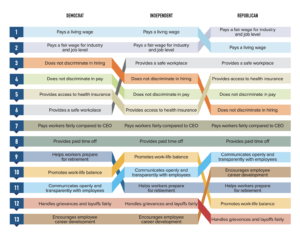‘Living wages’ has become a topic that is regularly and widely discussed, with increasing momentum behind initiatives across the globe. Stakeholders from different backgrounds and ideologies are coming together around the shared conviction that profit gained at the detriment of workers is simply unsustainable.
I recall the first multi-stakeholder living-wage meeting that I attended in Amsterdam in 2013, in the early part of this global movement. Sustainability leaders, certification systems, companies and ministries from three European countries were in attendance (U.S. policy makers were noticeably absent!). The purpose of the meeting was to begin building a common agenda to advance on living wages, with a focus on European procurement policies and supply chains in developing and transitional countries. But nobody was really discussing the need for living wages in “developed countries”. I remember asking a ministry representative if they planned to roll-out a living wage strategy domestically as well as internationally. The answer was no. Needless to say, this narrow view of the supply chain struck me as inadequate and has helped fuel my own work on living wages ever since.
Across the globe, individual companies and entire sectors are making major commitments to living wages, and some are putting real effort toward progress. Much of this effort has focused on workers at the bottom of supply chains – those working to produce raw materials or at manufacturing sites. Without a doubt, these supply chain workers are grossly underpaid and deserve living wages. Freedom from poverty is a human right, and many of the countries where these goods are produced are among the poorest in the world. And chronic poverty is a significant driver behind many other social problems – from food insecurity, physical and mental health issues, and poor academic achievement to child labor and bonded labor.
But we mustn’t forget that poverty and income inequality pervade even the richest countries in the world. Here in the United States, 50.8 million U.S. households struggle to put food on the table or pay for adequate shelter, routine medical attention, childcare, or transportation. 40% would find it difficult to cope with an unexpected expense of just $400. And low-income individuals in the U.S. have a lower life expectancy, and families suffer psychological consequences (JAMA, BMJ Open).
Over the last six years, my work has taken me to leading banana, cocoa, coffee and tea producing countries. When I talk about living wage, I am always dogged by a feeling of hypocrisy. And this is not lost on my international counterparts. Producer associations, growers, and unions alike have inquired whether living wages are paid in my home country. And the fact remains that most of those working on the front lines with American consumers – cashiers, grocery clerks, baristas, servers, etc. are not earning a living wage. Not to mention the people that care for us, our children and our elderly, keep are communities clean, and make life generally better – those that make up the fabric of our society.
What are we signaling to people of other nations when we push for living wages in their (often poorer) countries while failing to pay living wages in our own? And what are we saying to our neighbors when we focus on the wellbeing of people farther away while seemingly blind to those in front of us?
It is time for us all – employers, consumers and civil society – to look at living wage from a truly global perspective, including its imperative across entire supply chains, from production through consumption, and across every industry, whether consumer goods or services. Workers everywhere should be able to feed their families without sacrifice and afford a decent, if basic, standard of living. For employers – private, public, and non-profit – this starts by getting our own houses in order.
Peter Georgescu, Chairman Emeritus of Young and Rubicam, said it well:
What we desperately need now is not to abandon free market capitalism, but to correct its vision: to restore its broader sense of responsibility to multiple stakeholders, to our society as a whole.
Despite strong and well-intentioned advocacy and policy efforts, few places in the U.S. today have minimum wages that approach a living wage. Yet, according to Just Capital (2018), Americans rank living wage and worker benefits as the top considerations for U.S. companies. And while some employers have made living wages a top priority, there is no easy way for consumers and investors to identify which ones pay living wages, and how to support them.
Until now.
Living Wage For US is building a nonpartisan, market-led certification system that will focus on the entire supply chain, starting with U.S. employers that pay living wages to their own workers and contractors. Starting at home, we want to ensure that American workers are fairly compensated without prejudice. From there, we help certified employers build practical, global living wage policies that extend across supply chains and across the world.
This is an issue that affects us all and threatens our economy and international stability.
Are you concerned about living wages? Do you know if you pay living wages to your employees? Need help creating and implementing a strategy to improve worker wages, starting with your own U.S. operations? Living Wage For US is here to help! www.livingwageforus.org






